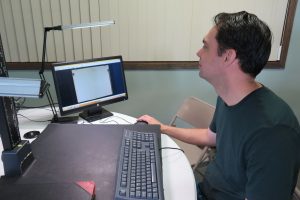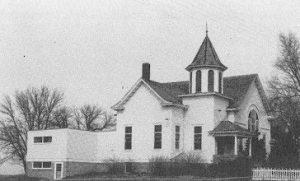The church books from the Bethlehem Covenant Church in Waverly give some clues about the origins and migration of many of the first Swedish immigrant families in southern Saunders and northern Lancaster counties in Nebraska.

Bethlehem Covenant was one of many churches in Nebraska that welcomed ArkivDigital in 2017 and Bethlehem’s records were filmed on July 19, 2017. Having easy access to these church books will yield huge dividends to my family history research – this will be the first of many posts about my findings.
The oldest church book at Waverly is the “Congregation Record” that starts in 1870. This book is patterned after the “Household Examination” books that were kept in the churches back in Sweden. It’s like a running census record for each family that belongs to the parish.

The Waverly book is especially valuable because in addition to places and dates of birth, baptism, marriage and death, the records also include the year of immigration and the last church attended – which might be a family’s intermediate stopping-point between Sweden and Waverly. Looking at the birth places of the children in each family also tells us something about the migration patterns for these families and possible commonalities. I am especially interested in learning what I can about Carl August Rudeen, among the very first Swedish settlers in this area. Carl August was an uncle to my great-grandfather Gust Rudeen. I believe Gust came to this part of Nebraska specifically because of his Uncle Carl.
I went through the book and extracted information about the earliest immigrant families – families where the parents were both born in Sweden. Some of them had married before coming to America and had children born in Sweden. There are about 41 families that fall into this classification. The heads of families came from the following counties (län) in Sweden:
| Län (County) | Number of Families |
| Gävleborg | 1 |
| *Jönköping | 12 |
| *Kalmar | 4 |
| Kristianstad | 1 |
| *Kronoberg | 2 |
| Malmöhus | 3 |
| Skaraborg | 1 |
| Värmland | 3 |
| Öland | 1 |
| Örebro | 1 |
| *Östergötland | 12 |
Counties marked with an asterisk are considered to be part of the province of Småland, so 30 out of 41 families (73% of the families in the church) were from Småland.
Uncle Carl was born at Marbäck parish (Jönköping in Småland), but as a young man he moved to nearby Askeryd parish (also Jönköping) where he married Sophia Mathilda Carlsdotter. There were many families in the Waverly Church that had roots in Askeryd:
- Carl August Johansson and Anna Maria Carlsdotter (although they share a surname, Anna Maria is not a sister of Sophia Mathilda)
- Charlotta Johnson, wife of John Alfred Johnson
- Sophia Mathilda Carlsdotter (wife of Uncle Carl)
- Alexander Sundin and his wife Clara Augusta
- Johanna Peterson, wife of Charles Peterson
- Lena Stina Carlson, wife of Carl August Sundin
- Anna Anderson, wife of Albin Anderson
It’s curious that it’s two men and seven women who share this ancestral parish.
Here are some other random observations:
- Another commonality we see in the parish is a large number of families who previously settled in Stark County, Illinois before coming to Waverly. At least four families lived for several years in Duncan, Illinois. A brief look at census records shows that they were farming there. My guess is that they were renting there and were lured to Waverly by the prospect of homesteading.
- A closer look at Uncle Carl’s family shows something interesting, too. Uncle Carl left Sweden in 1868. I had previously found Uncle Carl’s family in the 1870 census living in Altona, Illinois working for the railroad. The church record shows that he came to Waverly in 1872 from Fairfield, Iowa – so apparently the family had a one- or two-year stint in Iowa before coming to Nebraska. The area around Fairfield, Iowa is known as “New Sweden” and is home to the oldest Swedish-American church in the Midwest. It was founded by Peter Cassel who is associated with Kisa and Asby parishes in Östergotland. There are families in the Waverly church book from both of these parishes.
- Another family in Waverly, John Alfred and Charlotta Johnson, had lived at Bishop Hill, Illinois between 1875 and 1880. Bishop Hill is famous for the Jansonist colony that began there in the 1840’s.
- There are two different Samuelson families in the parish, which probably led to a lot of confusion. The John Magnus Samuelson family came to America in 1868 and lived in Stark County, Illinois for several years before coming to Waverly. They were probably homesteaders. The Daniel August Samuelson family didn’t come until 1882. Daniel August was originally from Lommaryd but lived in Askeryd before coming to America. One of Daniel August’s sons married one of Uncle Carl’s daughters.
- John and Carrie Larson came to Waverly from Skivarp in 1888. My Martinsson ancestors have roots in this parish.
By the way, I happened to stumble upon some better explanations of our surname Rudeen1. The original spelling was almost certainly Rudén or Rydén and is a combination of two words: ryd and én. The word ryd translates as a “woodland clearing” and is common word ending for village and parish names in Sweden – villages such as “Askeryd”, where Uncle Carl lived. The én suffix is a “latinized” definitive suffix denoting “the one and only”. The accent above the “e” indicates that you stress a syllable that you ordinarily wouldn’t. This is indeed how we pronounce the name: Rud-EEN, not RUD-een.
So “Rudeen” is pretty much a made-up name that has a bit of fancy Latin panache to it. As far as I know, Uncle Carl was the first to use this name.

Always a treat to read your posts
Thanks again Karen
Karen, can I see the records? Do you need to join something to look?
Lee
Yes, you have to have a subscription to ArkivDigital. A one-month subscription is about $35.
https://arkivdigital.net/
It takes a bit of doing to learn their interface but once you get the hang of it, it’s awesome. I have the full annual subscription.
If you decide to jump in, here are some video tutorials:
http://www.swedgensoc.org/2017/11/11/learn-arkivdigital/
I really appreciate the research into the Rudeen name. One shouldn’t have to go through your entire life not knowing what your name means or where it came from. I feel more complete.
I look forward to your entries Karen. They are so interesting!
Good answer, Dad! I like that Karen confirmed the pronunciation of our surname and that we haven’t messed that up from the original Swedish. I can now say that our last name means “the one and only woodland clearing” and David will love that there is clear cut (literally!) forestry involved in the translation! Would you say that this is a fair way to state the meaning of Rudeen? I love it. Thanks so much, Karen – this is very cool.
I had known that my maternal grandmother’s family (John Magnus Samuelson) had lived in Illinois before coming to Nebraska, but just learned when they arrived.
Always a joy to read your posts.